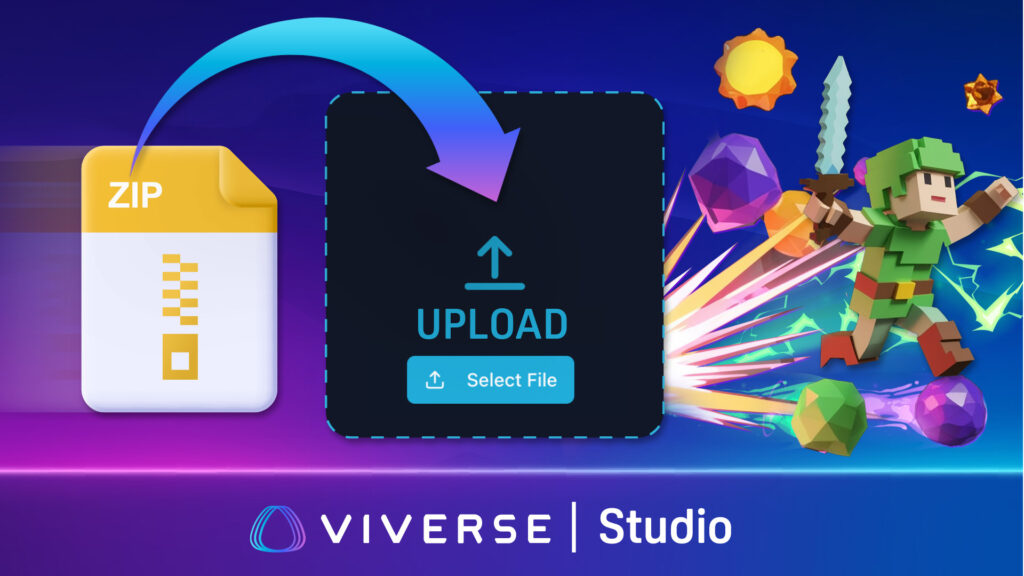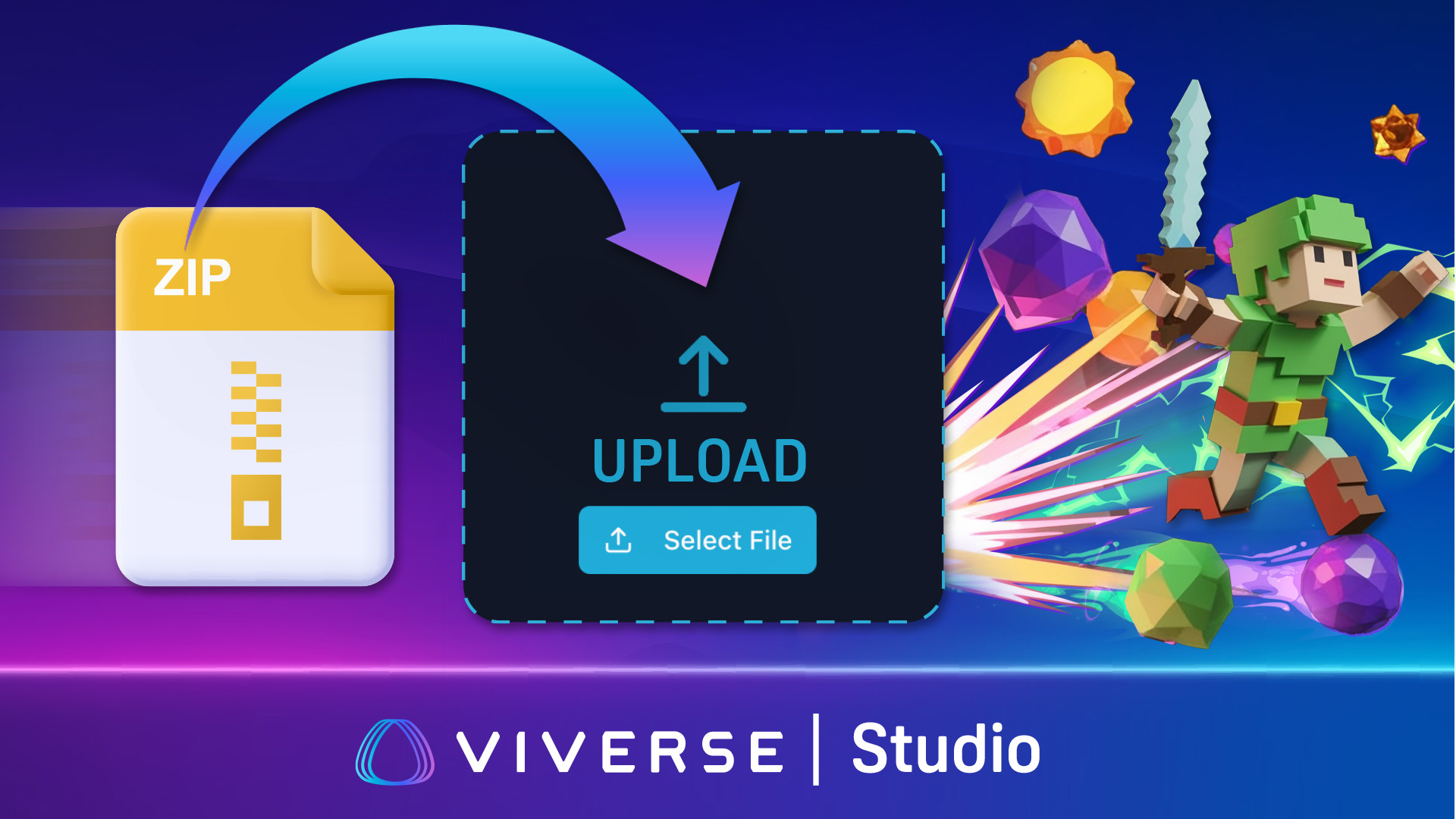How VIVERSE Studio Solves 5 Major Problems for 3D Creators
By: 庭庭迴旋踢 Edited by the VIVERSE Team
Publishing interactive 3D content is harder than it should be, but VIVERSE Studio 3D publishing fixes that with a simple zip-and-upload workflow. Whether you’re a game developer, a design student using a 3D creation suite for assignments, or an interior designer wanting to present real-time mockups to clients, each faces a common issue…
You Built Something in 3D, but Now What?
How do you share what you’ve built? How can others experience it directly? And how do you turn it into a meaningful portfolio that you can share with others?
The answer? VIVERSE Studio, where you can zip your build, drag it into your Studio dashboard, and have an instantly playable link on VIVERSE Worlds.
If you’re starting from scratch or need a quick on-ramp, try the VIVERSE Create v1.0 Quickstart guide, then bring assets in with our Blender -> VIVERSE Create Import guide.

In the past, publishing a 3D project online for interaction meant figuring out how to host it yourself, purchase server space, and conform to strict format and upload requirements across platforms. It was a messy and frustrating process. While creators now often use YouTube, Behance, ArtStation, or Notion to build their portfolios, these platforms still focus on static, 2D showcases, like videos, screenshots, or downloadable files, which fall short in delivering interactivity or immersion.
That’s where VIVERSE Studio comes in, filling the gap with a platform where 3D projects can be navigated, interacted with, and experienced directly in a web browser.
But What Does VIVERSE Studio Resolve for 3D Creators?
Let’s break it down into five core points that show how VIVERSE Studio is redefining the 3D creative landscape, and why it might be just what you need.
1. Fragmented Tool Ecosystem → Full Support for Mainstream WebXR Engines
One of the biggest challenges for 3D creators when approaching new platforms is whether it supports the tool(s) they use.
Different WebXR engines often have incompatible formats and deployment workflows. That means you might have to re-export or reformat your project just to get it running on a specific platform. Over time, this slows down your workflow and makes reuse or cross-platform sharing nearly impossible.
You don’t have to switch tools or re-export to a custom format. VIVERSE Studio supports a wide range of leading WebXR engines, including Unity WebGL, Three.js, Babylon.js, PlayCanvas, 8th Wall, and more. This means creators are no longer locked into a specific tool or format. As long as your project is built, just upload it as a ZIP file, and you’re ready to go live. No more getting stuck on compatibility issues, like engine compatibility or hosting headaches.
Learn more about VIVERSE’s engine-agnostic approach for a more open and immersive internet.
VIVERSE Studio creates a truly open and creative environment.

2. High Deployment Barriers → One ZIP 3D Publishing to Go Live
For many 3D creators, the biggest hurdle isn’t building content, it’s figuring out how to publish it online. Most XR platforms require installing SDKs, following rigid build instructions, or integrating time-eating backend systems when all you want to do is preview your world. On top of that, you’re often forced to convert your project into a specific format, learn unfamiliar tools, or manually tweak config files just to make it compatible. Even testing a simple demo can take hours.
VIVERSE Studio removes those barriers with a no-code 3D publishing workflow: just zip your project and upload it! Your experience becomes instantly playable on VIVERSE Worlds, and embeddable on your website, ready for others to explore—no installations, no technical overhead.
VIVERSE Studio means:
- No special formats to adhere to
- No new tools to learn (use what you know and love because VIVERSE is engine-agnostic!)
- No confusing config files to write and manage
- 3D publishing via drag-and-drop or using a command line interface (CLI) for powerful functionality
For designers, students, and indie creators, publishing 3D experiences online is now as easy as sharing a photo, dramatically lowering the entry barrier. It’s 3D deployment made simple!
3. Backend Functionality Is Hard → Built-in SDK for Multiplayer, Leaderboards, Account Systems
Want to add real interactivity to your 3D experience, like login systems, avatar selection, leaderboards, or multiplayer sync? For most small teams, that’s an impossible task. These features require backend development: account management, server architecture, real-time communication… skills that many frontend creators don’t have.
That’s why VIVERSE Studio includes a Game Services SDK, compatible across engines (Unity, Three.js, Godot, etc.). The SDK bundles essential backend modules, including user login, avatar integration, matchmaking, leaderboards, and multiplayer.

VIVERSE Studio simplifies backend integration with prebuilt modules. Even small teams can now create highly social, interactive 3D experiences without needing a dedicated backend engineer.
4. Difficult to Monetize → Creator Program and Subscription-Based Revenue Tools
Building a 3D world, game, or interactive experience takes serious time and skill. But for most creators, monetization has always been a dead end. You might spend weeks, months, or even years building a project, only to receive zero returns.
Unlike YouTube (with ad revenue) or livestreaming (with tips), 3D content has long lacked a proper revenue system.
VIVERSE is changing that with the launch of a Creator Program that provides funding support! Monetization tools are on their way, including a subscription feature.
That means whether you’re making mini-games, educational worlds, or immersive lore showcases, your audience can support you directly. It may not yet replace a full-time income, but it finally opens the door to sustainable creation through community support.

5. Hard to Build a Personal Brand → Creator Hub with SEO-Boosted Pages and Portfolio Management
Publishing your project is just step one. The real challenge? Getting people to remember who you are.
Many 3D creators have scattered portfolios — models on Sketchfab, videos on YouTube, notes on Notion. Viewers see the content but often can’t connect it to the creator. Without a unified entry point or brand identity, valuable collaboration or support opportunities are easily lost.
VIVERSE Studio solves this with custom creator profile pages. You can set your cover image, write your bio, link to social media, and embed both videos and interactive experiences — all under the viverse.com domain, boosted by built-in SEO benefits and a global CDN for smooth loading anywhere in the world.
Plus, the dashboard gives creators access to stats like views and average session time, helping you track what resonates and where to improve. Whether you’re just starting out or building a brand, this is your chance to connect your identity and your creations to one unified space — making it easier to be discovered and remembered.
Thinking About What Comes Next?
After reading these five key highlights, you might be wondering: what can this platform actually be used for?
One powerful idea: use VIVERSE Studio to share playable demos. Whether your project is in beta, mid-development, or still a prototype looking for funding or feedback, uploading it through VIVERSE Studio gives you a simple URL to share. Anyone can open it directly on their phone or desktop — no installation, no logins.
Thanks to iframe support, youcan even embed your experience on your own site. This removes the friction of downloads and installs, making trying out your 3D project or game as easy as watching a trailer. It’s a fast, effective way to get attract attention, gather feedback, and grow your community.
In short, VIVERSE Studio isn’t just another feature update. It’s a deliberate move to reshape the 3D creation ecosystem.
Now that the stage is set, we can’t wait to see what new tricks creators will come up with.
Ready to share your world with the rest of the internet?
Build in VIVERSE Create, then publish it instantly with VIVERSE Studio — no downloads, no headaches, just one upload away from going live.
👉 Start publishing with VIVERSE Studio
Looking to build a world or game? Explore VIVERSE Create
